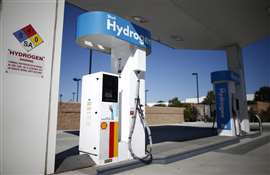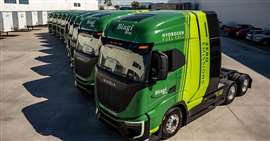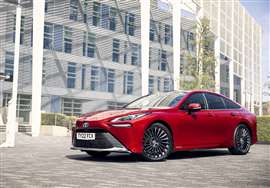Hydrogen refuelling stations should accommodate all customers
29 February 2024
 Shell hydrogen filling station in Torrance, California (Photo: Reuters and Lucy Nicholson)
Shell hydrogen filling station in Torrance, California (Photo: Reuters and Lucy Nicholson)
The delivery of 10 Tre fuel cell electric trucks to California-based Biagi Bros could be viewed as an industry landmark, for logistics providers everywhere and for Nikola, the truck OEM which has managed to remain in business despite a series of legal setbacks.
In the related press release, Nikola president and CEO, Michael Lohscheller, noted that the trucks would be refuelled at a hydrogen station in Ontario, California. A quick look on Google Maps reveals there are about 180 miles of highway between the Biagi Bros HQ in Napa, California and the Ontario refuelling stop.
So, while Ontario is close to the port terminal in Long Beach, an intermodal transport hub, the filling station is not exactly on the doorstep of the new FCEV truck owner.
 The 10 Nikola Tre FCEVs in Biagi Bros livery (Photo: Biagi Bros)
The 10 Nikola Tre FCEVs in Biagi Bros livery (Photo: Biagi Bros)
Fuel availability
In early February this year, energy giant Shell Oil (operating under Equilon Enterprises) reported that it would close almost all of its light-duty hydrogen filling stations in California. The outlet in Torrance is evidently still in operation, although the search is on for a new owner.
Prior to this in 2023, Shell announced that it was cancelling plans for an additional 48 new light-duty filling stations across California, despite having received government grants totalling $40.6 million in 2020.
According to media reports, the decision to close the H2 filling stations was due to ‘a number of market factors’. In this case, market factors were evidently a lack of hydrogen product and, critically, not enough customers to support the business.
This is not the first time Shell has closed light-duty H2 outlets. In 2022, the company closed its three sites in the UK, stating at the time that the first-generation prototype sites had reached their end-of-life.
In another case, Motive, Shell’s UK partner and a subsidiary of UK-based electrolyser manufacturer ITM Power, reported that it had needed to underwrite another (not Shell) hydrogen refuelling site to the tune of £2 million per year, before that was finally deemed unsustainable and the site was closed.
Light FCEVs
While correlation does not necessarily imply causation, the closing of the Shell H2 filling sites in the US and the UK appear directly linked to a lack of overall demand.
That’s not any great surprise; in the UK, only two hydrogen fuel cell electric models are available, the Hyundai Nexo and Toyota Mirai, and sales have been slow.
 Toyota Mirai - sales of all FCEVs has been slow (Photo: Toyota UK)
Toyota Mirai - sales of all FCEVs has been slow (Photo: Toyota UK)
In the US, the Mirai is currently the only FCEV available; Honda ended production of the Clarity FCEV in 2021. That said, Honda is now planning to launch a fuel cell/plug-in battery powered version of the CR-V crossover in North America and Japan.
But overall sales of FCEVs in the US and UK have remained stubbornly slow, due in no small measure to the high cost and, ironically, the lack of refuelling stations.
Reliant on trucks
In closing its H2 refuelling sites in the UK, Shell’s partner company Motive noted that the locations were too small to accommodate larger vehicles.
Does that mean that if these sites had been larger, then they might have remained open? More tellingly, was the inability to refuel trucks at the sites in California another reason behind the decision to call time on that business?
In the US in the 1980s, it was almost unheard of to find a diesel fuel pump on a standard forecourt. If you were running low, especially on a highway, you would invariably find yourself filling up with diesel on a remote pump set up to service the big rigs. Only years later did diesel become more commonplace across most light-vehicle forecourts.
Staying with the 1980s, it was not unusual for a sitcom to wrap up with the retelling of some moral story. If there’s any similar takeaway to be had from Shell closing its H2 filling stations in California – and even those in the UK – it could be that moving forward, flexibility in access to hydrogen filling stations will be the name of the game. After all, while sales of passenger car FCEVs have been light, the delivery of fuel cell trucks to Biagi Bros is just the beginning of the Class 8/heavy-duty story.
It is clearly tempting to add a hydrogen refuelling point to a standard gas/petrol station forecourt. Costs will be comparatively low and convenience high. But such a set up limits access to only passenger cars. Although it risks repeating the situation faced by diesel drivers in the 1980s, where they needed to share a pump with long-distance truckers, such shared accessibility could be the key to building turnover (in customer volumes and cold cash) and making hydrogen fuel retailing a more viable concern.
STAY CONNECTED




Receive the information you need when you need it through our world-leading magazines, newsletters and daily briefings.
POWER SOURCING GUIDE
The trusted reference and buyer’s guide for 83 years
The original “desktop search engine,” guiding nearly 10,000 users in more than 90 countries it is the primary reference for specifications and details on all the components that go into engine systems.
Visit Now
CONNECT WITH THE TEAM










